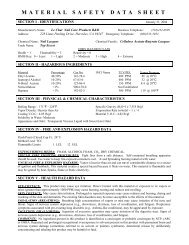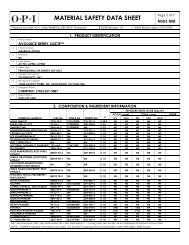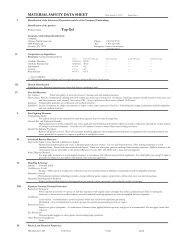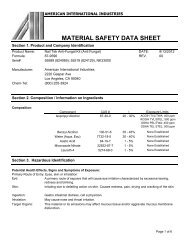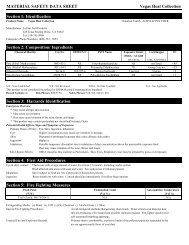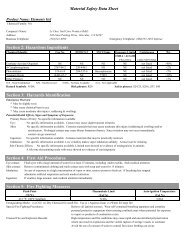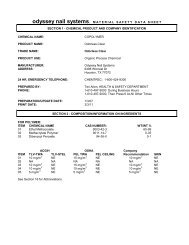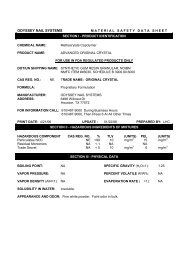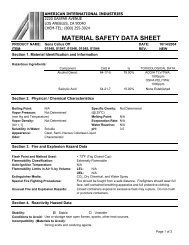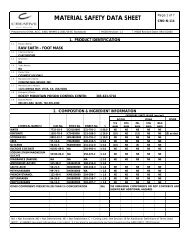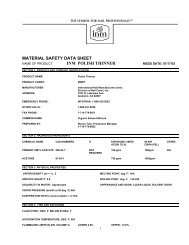MATERIAL SAFETY DATA SHEET - Trans Design
MATERIAL SAFETY DATA SHEET - Trans Design
MATERIAL SAFETY DATA SHEET - Trans Design
Create successful ePaper yourself
Turn your PDF publications into a flip-book with our unique Google optimized e-Paper software.
<strong>MATERIAL</strong> <strong>SAFETY</strong> <strong>DATA</strong> <strong>SHEET</strong><br />
Page 1 of 7<br />
CND-N-048<br />
Prepared to OSHA, ACC, ANSI and WHMIS Standards MSDS Revision Date 11/01/2002<br />
1.1 Product Name:<br />
SOLARSPEED SPRAY<br />
1.2 Chemical Name:<br />
1. PRODUCT IDENTIFICATION<br />
1.3 Synonyms:<br />
1.4 Trade Names:<br />
1.5 Product Use:<br />
COSMETIC USE ONLY<br />
1.6 Manufacturer’s Name:<br />
CREATIVE NAIL DESIGN, INC.<br />
1.7 Manufacturer’s Address:<br />
1125 JOSHUA WAY, VISTA, CA U.S.A., 92083<br />
1.8 Emergency Phone:<br />
ROCKY MOUNTAIN POISON CONTROL CENTER: 1-303-623-5716<br />
1.9 Business Phone:<br />
1-877-CND-NAIL (877-263-6245)<br />
CHEMICAL NAME(S) CAS NO. %<br />
2. COMPOSITION & INGREDIENT INFORMATION<br />
ACGIH<br />
EXPOSURE LIMITS IN AIR<br />
HEXAMETHYLDISILOXANE 107-46-0 < 78 0.3 mg/m 3 NE 0.3 mg/m 3 NE NE (C)<br />
CYCLOMETHICONE NA 10 NE NE NE NE NE<br />
ETHYLHEXYL PALMITATE NA 5 NE NE NE NE NE<br />
PRUNUS AMYGDALUS DULCIS<br />
(SWEET ALMOND) OIL<br />
TLV<br />
ppm<br />
STEL<br />
ppm<br />
PEL<br />
ppm<br />
OSHA<br />
STEL<br />
ppm<br />
IDLH<br />
ppm<br />
NA
<strong>MATERIAL</strong> <strong>SAFETY</strong> <strong>DATA</strong> <strong>SHEET</strong><br />
Page 2 of 7<br />
CND-N-048<br />
Prepared to OSHA, ACC, ANSI and WHMIS Standards MSDS Revision Date 11/01/2002<br />
3.1 Hazard Identification:<br />
3. HAZARD IDENTIFICATION<br />
3.2 Routes of Entry: Inhalation: YES Absorption: YES Ingestion: YES<br />
3.3 Effects of Exposure:<br />
Inhalation: Material may be irritating to mucous membranes.<br />
Ingestion: Material may be irritating to mucous membranes.<br />
Eyes & Skin: May cause eye irritation. May cause skin irritation.<br />
3.4 Symptoms of Overexposure:<br />
Redness, watering or swelling, if in eyes. Redness, irritation or itching on skin at site of contact.<br />
3.5 Acute Health Effects:<br />
Vapor or mist may be irritating to eyes, mucous membranes & upper respiratory tract. May cause skin irritation at site of contact in<br />
some sensitive individuals.<br />
3.6 Chronic Health Effects:<br />
None known.<br />
3.7 Target Organs:<br />
Eyes and skin.<br />
4.1 First Aid:<br />
Inhalation:<br />
Eyes & Skin:<br />
Ingestion:<br />
4.2 Medical Conditions Aggravated by Exposure:<br />
None known.<br />
4. FIRST AID MEASURES<br />
If irritation occurs remove affected individual to fresh air. If breathing is difficult, give oxygen. If breathing stops,<br />
perform artificial respiration at once. Seek immediate medical attention.<br />
In case of contact, immediately flush eyes with copious amounts of water for at least 15 minutes. Open and close<br />
eyelid(s) to ensure thorough irrigation. If irritation persists, consult a physician. In case of skin irritation, immediately<br />
wash skin with soap and copious amounts of water. Do not wear contaminated clothing until after it has been properly<br />
cleaned. If irritation persists, consult a physician.<br />
If swallowed, wash out mouth with water. Call a physician<br />
HEALTH 1<br />
FLAMMABILITY 2<br />
REACTIVITY 0<br />
PROTECTIVE EQUIPMENT
<strong>MATERIAL</strong> <strong>SAFETY</strong> <strong>DATA</strong> <strong>SHEET</strong><br />
Page 3 of 7<br />
CND-N-048<br />
Prepared to OSHA, ACC, ANSI and WHMIS Standards MSDS Revision Date 11/01/2002<br />
5. FIREFIGHTING MEASURES<br />
5.1 Flashpoint & Method:<br />
120°F (calculated)<br />
5.2 Autoignition Temperature:<br />
ND<br />
5.3 Flammability Limits: Lower Explosive Limit (LEL): Upper Explosive Limit (UEL):<br />
5.4 Fire & Explosion Hazards:<br />
Flammable.<br />
5.5 Extinguishing Methods:<br />
CO2, Halon, Dry Chemical, Foam, Water<br />
5.6 Firefighting Procedures:<br />
Wear self-contained breathing apparatus and protective clothing to prevent contact<br />
with skin and eyes. Emits toxic fumes under fire conditions. Structural firefighters must<br />
wear SCBAs and full protective equipment. Use a water spray or fog to reduce or<br />
direct vapors. Water may not be effective in actually extinguishing a fire involving this<br />
product.<br />
2<br />
1 0<br />
RED = FLAMMABILITY<br />
BLUE = HEALTH<br />
YELLOW = REACTIVITY<br />
WHITE = SPECIAL MEASURES<br />
0 = NO HAZARD<br />
1 = MINIMAL HAZARD<br />
2= SLIGHT HAZARD<br />
3 = MODERATE HAZARD<br />
4 = SEVERE HAZARD<br />
6.1 Spills:<br />
6. ACCIDENTAL RELEASE MEASURES<br />
Before cleaning any spill or leak, individuals involved in spill cleanup must wear appropriate Personal Protective Equipment.<br />
For small spills (e.g.,
<strong>MATERIAL</strong> <strong>SAFETY</strong> <strong>DATA</strong> <strong>SHEET</strong><br />
Page 4 of 7<br />
CND-N-048<br />
Prepared to OSHA, ACC, ANSI and WHMIS Standards MSDS Revision Date 11/01/2002<br />
8.1 Ventilation & Engineering Controls:<br />
8. EXPOSURE CONTROLS & PERSONAL PROTECTION<br />
When working with large quantities (≥ 1 gallon) of product, provide adequate ventilation (e.g., local exhaust ventilation, fans). Ensure<br />
that an eyewash station, sink or washbasin is available in case of exposure to eyes.<br />
8.2 Respiratory Protection:<br />
No special respiratory protection is required under normal conditions of use or handling. If necessary, use only respiratory protection<br />
authorized per U.S. OSHA's requirement in 29 CFR §1910.134, or applicable U.S. state regulations, or the appropriate standards of<br />
Canada, its provinces, E.C. member states, or Australia.<br />
8.3 Eye Protection:<br />
Avoid eye contact. None required under normal conditions of use. However, may cause irritation in some sensitive individuals.<br />
When handling large quantities (e.g., ≥ 1 gallon), safety glasses with side shields should be used.<br />
8.4 Hand Protection:<br />
None required under normal conditions of use. However, may cause skin irritation in some sensitive individuals.<br />
When handling large quantities (e.g., ≥ 1 gallon), wear rubber or plastic impervious gloves.<br />
8.5 Body Protection:<br />
No apron required when handling small quantities.<br />
When handling large quantities (e.g., ≥ 1 gallon), eye wash stations and deluge showers should be available. Upon completion of<br />
work activities involving large quantities of this product, wash any exposed areas thoroughly with soap and water.<br />
9.1 Density: 0.8<br />
9.2 Boiling Point: > 212°F<br />
9.3 Melting Point: NA<br />
9.4 Evaporation Rate: NA<br />
9.5 Vapor Pressure: NA<br />
9.6 Molecular Weight: NA<br />
9.7 Appearance & Color: Clear liquid.<br />
9.8 Odor Threshold: NA<br />
9.9 Solubility: Insoluble.<br />
9.10 pH NA<br />
9.11 Viscosity: NA<br />
9.12 Other Information: NA<br />
9. PHYSICAL & CHEMICAL PROPERTIES<br />
10. STABILITY & REACTIVITY<br />
10.1 Stability: Stable under ambient conditions.<br />
10.2 Hazardous Decomposition Products: Oxides of carbon and nitrogen.<br />
10.3 Hazardous Polymerization: Will not occur.<br />
10.4 Conditions to Avoid: Exposure or contact with extreme temperatures or incompatible materials.<br />
10.5 Incompatible Substances: Strong oxidizers, acids and alkalis.<br />
11. TOXICOLOGICAL INFORMATION<br />
11.1 Toxicity Data: This product has not been tested on animals to obtain toxicological data. There are toxicology data<br />
for the components of this product, which are found in the scientific literature. These data have not<br />
been presented in this document.<br />
11.2 Acute Toxicity: See Section 3.3<br />
11.3 Chronic Toxicity: See Section 3.6<br />
11.4 Suspected Carcinogen: NE
<strong>MATERIAL</strong> <strong>SAFETY</strong> <strong>DATA</strong> <strong>SHEET</strong><br />
Page 5 of 7<br />
CND-N-048<br />
Prepared to OSHA, ACC, ANSI and WHMIS Standards MSDS Revision Date 11/01/2002<br />
11.5 Reproductive Toxicity: None<br />
Mutagenicity:<br />
This product is not reported to produce mutagenic effects in humans.<br />
Embryotoxicity:<br />
This product is not reported to produce embryotoxic effects in humans.<br />
Teratogenicity:<br />
This product is not reported to cause teratogenic effects in humans.<br />
Reproductive Toxicity:<br />
This product is not reported to cause reproductive effects in humans.<br />
11.6 Irritancy of Product: See Section 3.3<br />
11.7 Biological Exposure Indices: NE<br />
11.8 Physician Recommendations: Treat symptomatically.<br />
12.1 Environmental Stability:<br />
12. ECOLOGICAL INFORMATION<br />
This product will slowly volatile from soil. Components of this product will slowly decompose into<br />
organic compounds.<br />
12.2 Effects on Plants & Animals: There are no specific data available for this product.<br />
12.3 Effects on Aquatic Life: There are no specific data available for this product.<br />
13.1 Waste Disposal:<br />
13. DISPOSAL CONSIDERATIONS<br />
Dispose of in accordance with all Federal, state, and local regulations.<br />
13.2 Special Considerations:<br />
U.S. EPA WASTE NUMBER: D001<br />
14. TRANSPORTATION INFORMATION<br />
The basic description (proper shipping name, hazard class & division, ID Number, packing group) is shown for each mode of transportation.<br />
Additional descriptive information may be required by 49 CFR, IATA/ICAO, IMDG and the CTDGR.<br />
14.1 49 CFR (GND):<br />
NOT REGULATED BY THIS MODE<br />
14.2 IATA (AIR):<br />
CONSUMER COMMODITY, 9, ID8000<br />
14.3 IMDG (OCN):<br />
FLAMMABLE LIQUID, N.O.S. (hexamethyldisiloxane), 3, UN1993, III, LTD QTY<br />
14.4 TDGR (Canadian GND):<br />
MARK PACKAGE "LIMITED QUANTITY" or "QUANTITÉ LIMITÉE" or "LTD QTY" or "QUANT LTÉE"
<strong>MATERIAL</strong> <strong>SAFETY</strong> <strong>DATA</strong> <strong>SHEET</strong><br />
Page 6 of 7<br />
CND-N-048<br />
Prepared to OSHA, ACC, ANSI and WHMIS Standards MSDS Revision Date 11/01/2002<br />
15.1 SARA Reporting Requirements:<br />
15. REGULATORY INFORMATION<br />
15.2 SARA Threshold Planning Quantity:<br />
There are no specific Threshold Planning Quantities for the components of this product.<br />
15.3 TSCA Inventory Status:<br />
The components of this product are listed on the TSCA Inventory.<br />
15.4 CERCLA Reportable Quantity (RQ):<br />
15.5 Other Federal Requirements:<br />
This product complies with the appropriate sections of the Food and Drug Administration's 21 CFR subchapter G (Cosmetics).<br />
15.6 Other Canadian Regulations:<br />
This product has been classified according to the hazard criteria of the CPR and the<br />
MSDS contains all of the information required by the CPR. The components of this<br />
product are listed on the DSL/NDSL. None of the components of this product are listed<br />
on the Priorities Substances List. Class B2 Flammable Liquid.<br />
15.7 State Regulatory Information:<br />
.<br />
16.1 Other Information:<br />
16. OTHER INFORMATION<br />
Flammable. Use only as directed. KEEP OUT OF REACH OF CHILDREN. Discontinue use immediately if irritation develops. Avoid eye<br />
contact. If eye contact occurs, flush with water. Do not ingest. If swallowed, do not induce vomiting; seek medical attention.<br />
16.2 Terms & Definitions:<br />
See page 7 of this MSDS.<br />
16.3 Disclaimer:<br />
This Material Safety Data Sheet is offered pursuant to OSHA’s Hazard Communication Standard, 29 CFR §1910.1200. Other<br />
government regulations must be reviewed for applicability to this product. To the best of ShipMate's & Creative Nail <strong>Design</strong>'s<br />
knowledge, the information contained herein is reliable and accurate as of this date; however, accuracy, suitability or completeness<br />
are not guaranteed and no warranties of any type, either expressed or implied, are provided. The information contained herein<br />
related only to the specific product(s). If this product(s) is combined with other materials, all component properties must be<br />
considered. Data may be changed from time to time. Be sure to consult the latest edition.<br />
16.4 Prepared for:<br />
Creative Nail <strong>Design</strong>, Inc.<br />
1125 Joshua Way<br />
Vista, CA 92083<br />
1-877-CND-NAIL (877-263-6245) phone<br />
760-599-4005 fax<br />
http://www.creativenaildesign.com/<br />
16.5 Prepared by:<br />
ShipMate, Inc.<br />
18436 Hawthorne Boulevard, Suite 201<br />
Torrance, CA 90504<br />
310-360-3700 phone<br />
310-360-5700 fax<br />
http://www.shipmate.com/
<strong>MATERIAL</strong> <strong>SAFETY</strong> <strong>DATA</strong> <strong>SHEET</strong><br />
Page 7 of 7<br />
CND-N-048<br />
Prepared to OSHA, ACC, ANSI and WHMIS Standards MSDS Revision Date 11/01/2002<br />
DEFINITIONS OF TERMS<br />
A large number of abbreviations and acronyms appear on a MSDS. Some of these that are commonly used include the following:<br />
CAS #: This is the Chemical Abstract Service Number that uniquely identifies<br />
each constituent.<br />
EXPOSURE LIMITS IN AIR:<br />
ACGIH – The American Conference on Governmental Industrial Hygienists, a<br />
professional association that establishes exposure limits.<br />
TLV – Threshold Limit Value – an airborne concentration of a substance that<br />
represents conditions under which it is generally believed that all workers may<br />
be repeatedly exposed without adverse effect. The duration must be<br />
considered, including the 8-hour Time Weighted Average (TWA), the 15-<br />
minute Short Term Exposure Limit, and the instantaneous Ceiling Level (C). Skin<br />
absorption effect must also be considered.<br />
OSHA – U.S. Occupational Safety and Health Administration<br />
PEL – Permissible Exposure Limit – This exposure value means exactly the same<br />
as TLV, except that it is enforceable by OSHA. The OSHA Permissible Exposure<br />
Limits are based in the 1989 PELs and the June 1993 Air Contaminants Rule<br />
(Federal Register: 58: 35338-35351 and 58: 40191). Both the current PELs and<br />
the vacated PELs are indicated. The phrase “Vacated 1989 PEL,” is placed<br />
next to the PEL which was vacated by Court Order.<br />
IDLH – Immediately Dangerous to Life and Health – This level represents a<br />
concentration from which one can escape within 30-minutes without suffering<br />
escape-preventing or permanent injury. The DFG – MAK is the Republic of<br />
Germany’s Maximum Exposure Level, similar to the U.S. PEL. NIOSH is the<br />
National Institute of Occupational Safety and Health, which is the research<br />
arm of the U.S. Occupational Safety and Health Administration (OSHA). NIOSH<br />
issues exposure guidelines called Recommended Exposure Levels (RELs). When<br />
no exposure guidelines are established; an entry of NE is made for reference.<br />
FIRST AID MEASURES:<br />
CPR: Cardiopulmonary resuscitation. Method in which a person whose heart<br />
has stopped receives manual chest compressions and breathing to circulate<br />
blood and provide oxygen to the body.<br />
HAZARD RATINGS:<br />
HAZARDOUS <strong>MATERIAL</strong>S IDENTIFICATION SYSTEM: This rating system was<br />
developed by the National Paint and Coating Association and has been<br />
adopted by industry to identify the degree of chemical hazards. Health<br />
Hazard: 0 (minimal acute or chronic exposure hazard); 1 (slight acute or<br />
chronic exposure hazard); 2 (moderate acute or significant chronic exposure<br />
hazard); 3 (severe acute exposure hazard; onetime overexposure can result in<br />
permanent injury and may be fatal); 4 (extreme acute exposure hazard;<br />
onetime overexposure can be fatal). Flammability hazard: 0 (minimal<br />
hazard); 1 (materials that require substantial pre-heating before burning; 2<br />
(combustible liquids or solids; liquids with a flashpoint of 38-93C [100-200F]); 3<br />
(Class 1B and 1C flammable liquids with flash points below 38C [100F]; 4 (Class<br />
1A flammable liquids with flash points below 23C [73F] and boiling points<br />
below 38C [100F]. Reactivity Hazard: 0 (normally stable); 1 (materials that<br />
can become unstable at elevated temperatures or which can react slightly<br />
with water); 2 (materials that are unstable but do not detonate when initiated<br />
or which can react violently with water); 3 (materials that can detonate when<br />
initiated or which can react explosively with water); 4 (materials that can<br />
detonate at normal temperatures or pressures). PPE Rating B: Hand and eye<br />
protection is required for routine chemical use.<br />
NATIONAL FIRE PROTECTION ASSOCIATION: Health Hazard: 0 (material that on<br />
exposure under fire conditions would offer no hazard beyond that of ordinary<br />
combustible materials); 1 (materials that on exposure under fire conditions<br />
could cause irritation or minor residual injury); 2 (materials that on intense or<br />
continued exposure under fire conditions could cause temporary<br />
incapacitation or possible residual injury); 3 (materials that can on short<br />
exposure could cause serious temporary or residual injury); 4 (material that<br />
under very short exposure could cause death or major residual injury).<br />
Flammability Hazard and Reactivity Hazard: Refer to definitions for<br />
“Hazardous Materials Identification System.”<br />
FLAMMABILITY LIMITS IN AIR:<br />
Much of the information related to fire and explosion is derived from the<br />
National Fire Protection Association (NFPA). Flash Point – minimum<br />
temperature at which a liquid gives off sufficient vapors to form an ignitable<br />
mixture with air. Autoignition Temperature: The minimum temperature<br />
required to initiate combustion in air with no other source of ignition. LEL –<br />
the lowest percent of vapor in air, by volume, that will explode or ignite in<br />
the presence of an ignition source. UEL – the highest percent of vapor in air ,<br />
by volume, that will explode or ignite in the presence of an ignition source.<br />
TOXICOLOGICAL INFORMATION:<br />
Human and Animal Toxicology: Possible health hazards as derived from<br />
human data, animal studies, or from the results of studies with similar<br />
compounds are presented. Definitions of some terms use dint his section are:<br />
LD50 – Lethal Dose (solids & liquids) which kills 50% of the exposed animals;<br />
LC50 – Lethal concentration (gases) which kills 50% of the exposed animals;<br />
ppm – concentration expressed in parts of material per million parts of air or<br />
water; mg/m 3 - concentration expressed in weight of substance per volume<br />
of air; mg/kg quantity of material, by weight, administered to a test subject,<br />
based on their body weight in kg. Other measures of toxicity include TDlo,<br />
the lowest dose to cause a symptom and TCLo the lowest concentration to<br />
cause a symptom; TDlo, LDlo, and LDo, or TC, TCo, LClo, and LCo, the lowest<br />
dose (or concentration) to cause lethal or toxic effects. Cancer Information:<br />
The sources are: IARC – the International Agency for Research on Cancer;<br />
NTP – the National Toxicology Program, RTECS – the Registry of Toxic Effects of<br />
Chemical Substances, OSHA and CAL/OSHA. IARC and NTP rate chemicals<br />
on a scale of decreasing potential to cause human cancer with rankings<br />
from 1 to 4. Sub rankings (2A, 2B, etc.) are also used. Other Information: BEI<br />
– ACGIH Biological Exposure Indices, represent the levels of determinants<br />
which are most likely to be observed in specimens collected from a health<br />
worker who has been exposed to chemical to the same extent as a worker<br />
with inhalation exposure to the TLV. Ecological Information: EC is the effect<br />
concentration in water. BCF – Bioconcentration Factor, which is used to<br />
determine if a substance will concentrate in life forms that consume<br />
contaminated plant or animal matter. TLm – median threshold limit;<br />
Coefficient of Oil/Water Distribution is represented by log KOW or log KOC and<br />
is used to assess a substance’s behavior in the environment.<br />
REGULATORY INFORMATION:<br />
U.S. and CANADA: This section explains the impact of various laws and<br />
regulation of the material. EPA is the U.S. Environmental Protection Agency.<br />
WHMIS is the Canadian Workplace Hazardous Material Information System.<br />
DOT and TC are the U.S. Department of <strong>Trans</strong>portation and <strong>Trans</strong>port<br />
Canada, respectively. Superfund Amendments and Reauthorization Act<br />
(SARA); the Canadian Domestic/Non-Domestic Substance List (DSL/NDSL);<br />
the U.S. Toxic Substance Control Act (TSCA); Marine Pollutant status<br />
according to the DOT; the Comprehensive Environmental Response,<br />
Compensation, and Liability Act (CERCLA or Superfund); and various state<br />
regulations. This section also includes information on the precautionary<br />
warnings that appear on the material’s package label.<br />
EUROPEAN and INTERNATIONAL: EC is the European Community, formerly<br />
known as the EEC, European Economic Community). EINECS: This is the<br />
European Inventory of Now-Existing Chemical Substances. AICS is the<br />
Australian Inventory of Chemical Substances. MITI is the Japanese Minister of<br />
International Trade and Industry. ECL is the Korean Existing Chemicals List.<br />
IMO is the International Maritime Organization and IATA is the International<br />
Air <strong>Trans</strong>port Association. The ARD is the European Agreement Concerning<br />
the International Carriage of Dangerous Goods by Road and the RID are the<br />
International Regulations Concerning the Carriage of Dangerous Goods by<br />
Rail.<br />
FLAMMABILITY<br />
HEALTH<br />
SPECIAL<br />
PRECAUTIONS<br />
REACTIVITY



